I Don't Give a Dram
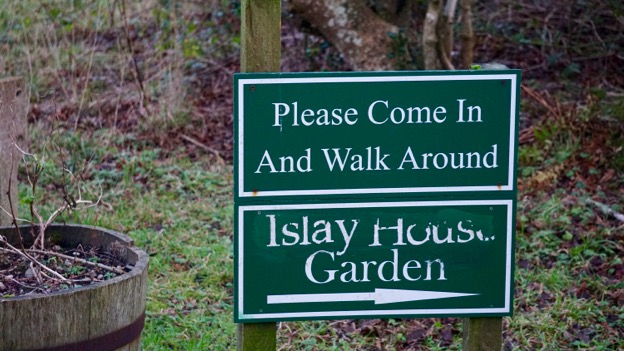
When I tell people I visited the Scottish island of Islay (pronounced “eye-lah”) over New Year’s, but didn’t tour of any of its 8 whisky distilleries, I am met with understandable confusion. After all, Islay’s single-malt whiskies are world-renowned. My favorite is Lagavulin, a smoky whisky from the south end of the island. Laphroaig is well known for its smoky earthiness while Bruichladdich whiskies are reputed to be among Scotland’s most “heavily peated”.
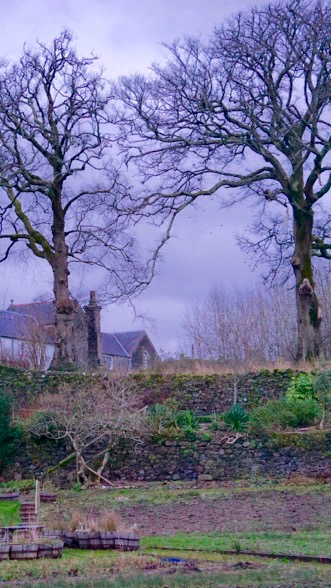
Confusion morphs into eye rolling when I explain that I toured a garden instead. After being driven through beautiful landscapes; taking a stroll on a sandy beach cleansed by salt-spraying breakers that reminded me of childhood walks on Washington State’s Pacific coast; and visiting one of Islay’s ruined churches, my hosts, a generous Edinburgh couple, indulged me with a walk through a centuries old vegetable garden, now in its second iteration. As a garden designer, I was thrilled.
You might wonder at the impulse to visit a garden at this time of year, especially when warm whisky tasting rooms beckon, but I find that winter is when many gardens are at their most interesting. The wintery Islay House Community Garden, surrounded by a lichen-covered woodland and flocks of geese flying overhead, was no exception. In fact, it was pure heaven.
The 4.5 acre garden began providing produce for the Campbells, the hereditary owners and Lairds of Islay, in the early 1700’s, and continued to provide Islay House residents with vegetables until the 1960’s. Thereafter it fell into disuse and by 2005 was utterly overgrown, its greenhouses derelict and beyond repair. The Bridgend County Centre Committee, a group of citizens, leased the garden, and fortified by volunteers and partner organizations, has transformed it back into a productive and working kitchen garden, growing and selling a diverse range of fruits, vegetables, and herbs. The island newspaper, The Ilieach, and the garden’s Facebook page advertise what is available and, as late as Christmas proclaimed that the garden was still offering sprouts, parsnips, red cabbage, green cabbage, kale, peppers, garlic, and “the last of the year’s potatoes”.
We arrived late in the day, just as the overcast Hebridean sky was darkening. I was guided to an unassuming small, red door in a corner of the stonewall that encircles it. This wall is so massively formidable that it could undoubtedly withstand attack by the most vicious of enemies, let alone ravenous rabbits and freezing winds.

I managed to wrestle the rain-swollen door open and stepped onto the elevated walkway that runs along the base of the wall. It was like stepping into Frances Hodgson Burnett’s “Secret Garden”. Before me was a large, complex garden just waiting to be explored.
The upper walkway was bordered by perennials, shrubs, and trees, beautiful stone work, pathways, and blankets of thick, verdant moss worthy of Kōinzan Saihō-ji, the famous Moss Temple in Kyoto. The surprising collection of yuccas, fatsias ((Fatsia japonica), pampas grasses (Pampus cortidaria), and other exotic shrubs lining the walk evidently comprise a plant collection that was imported from as far away as New Zealand and Chile during Victorian times. The garden is even known among tree enthusiasts for its “champion trees”, including a large New Zealand Ribbonwood (Plagianthus regius), which is has been entered into the UK Tree Register. These plants and trees must have been difficult to procure in the 1800’s, and were probably even more difficult to import since they would have had to come by wagon and boat. They would have been highly prized and assiduously tended by teams of laborers in a time when labor was relatively cheap. It is easy to imagine the proud
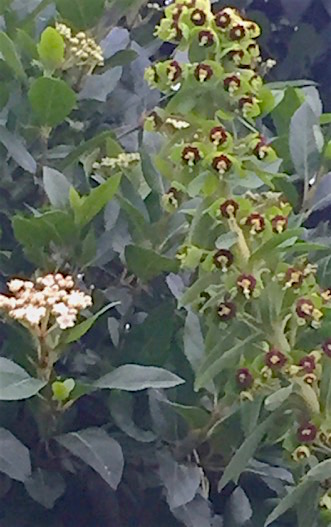
owners of Islay House bringing visitors to see their burgeoning plant collection. Would they have shared cuttings of their shrubby treasures?
Given the unusual mildness of the current UK winter, several perennials and plants were unexpectedly in bloom. Especially eye-catching was a Laurustinus (Viburnum titanus) that was covered in small flat clusters of tiny pure white flowers. I love this spring blooming viburnum, though I am disappointed that it doesn’t have a fragrance comparable to some of its other early blooming cousins. A large clump of May-blooming spurge (Euphorbia characias subsp. Wulfenii), growing beside the Laurustinus was also in full, but unseasonable bloom. Together they made a pretty composition on this leaden day.
On the garden’s bottom level, the remnants of last autumn’s veg crop were still growing in well-organized beds. Several rows of unpicked Brussels sprouts had been allowed to grow out of control to the extant that the sprouts resembled mutant cabbages. Beside them grew rows of tall dark purple kale next to dark green kale, contrasting beautifully with one another. Several rows of Swiss chard, a cheerful show of red, green, and burgundy leaves in the bleak, fading light, was ready for harvest. A little further on was an emergent crop of leeks, harbingers of spring’s earliest crops.
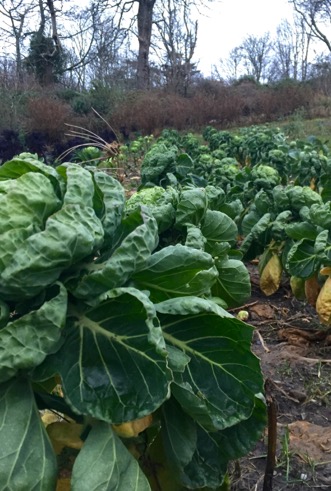
Fortunately, the garden’s formal architectural and planting features have been preserved, a reverent acknowledgement of its heyday. They were situated at the same end of the garden as the door through which we’d entered. A simple boxwood parterre divides wide, gracious steps leading from a sundial and a hornbeam arbor up to the site where the greenhouses once stood. The building that once comprised the back wall of the greenhouses still stands and it is easy to imagine smoke curling from its chimneys on cold days when fires were stoked to keep tender plants warm. Perhaps inside were potted fruit trees, forced to bloom early, were carefully pollinated by gentle gardeners who dabbed pollen-covered rabbit foot brushes across cherry, peach, or apple blossoms to stimulate an unseasonably early crop of fruit. There must have been pots of exotic flowers that could be taken to the house for decoration and trays of early greens.
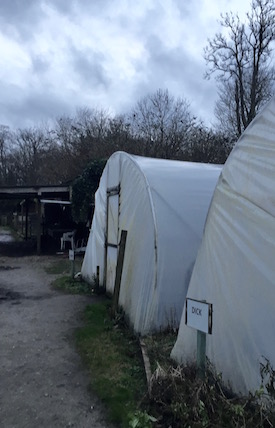
In place of the long-gone greenhouses, three white plastic “tunnel houses” (amusingly dubbed “Tom, Dick, and Harry”, like the tunnels in “The Great Escape”) looked startling modern in this landscape. I didn’t dare peak inside, but suspect they were full of flats planted with onion and garlic seedlings and even annuals, all to be planted outside after being carefully hardened off in warmer weather.
By the time we’d completed our circuit and found ourselves back at the door in the wall, the daylight had waned and it was time to return to the house on Loch Indaal for the traditional New Year’s Day meat pie supper. After dinner, my hosts brought out a beautiful bottle of Bruichladdich whisky and a small pitcher of water: The final touch to a perfect New Year’s Day.
